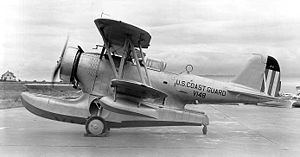Wingspan 12 m Introduced 1935 | Length 9.931 m | |
 | ||
Engine type Pratt & Whitney R-1830 Twin Wasp | ||
The Grumman JF "Duck" was an American single-engine amphibious biplane built by Grumman for the United States Navy during the 1930s. The J2F Duck was an improved version of the JF, with its main difference being a longer float.
Contents
Design and development
The Grumman JF Duck was manufactured from 1934 until 1936, when production switched to the J2F Duck and later variants. The more obvious external appearance clue to distinguish a JF from an early J2F is the deletion of the inter-aileron strut between the wings on the J2F; less noticeable perhaps is the J2F's slightly longer rear fuselage/float joining fillet beneath the tail.
The Duck's main pontoon was part of the fuselage, almost making it a flying boat, though it appears more like a standard aircraft with an added float. This general configuration was shared with the earlier Loening OL. The XJF-1 prototype first flew on 24 April 1933 piloted by Grumman test pilot Paul Hovgard.
Operational history
The JF-1 that was first ordered, had the same Pratt & Whitney R-1830-62 engine as the XJF-1 prototype. The US Navy ordered 27 JF-1s with the first Ducks delivered beginning in May 1934 to Norfolk NAS. These early production series had provisions for mounting a machine gun at the rear seat facing aft, a single bomb rack mounted under each wing, capable of carrying a 100 lb (45.4 kg) bomb or depth charge on each. The main float was also a Grumman design (Grumman Model "A") and like the prototype, it included retractable main landing gear, making the Duck a true amphibian. Ducks served as general/utility amphibians for photographic, target-towing, scouting and rescue work.
Variants
Operators
Argentina
Specifications (JF-2)
Data from
General characteristics
Performance
